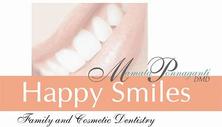
Questions About Family or Cosmetic Dentistry?
Below is a list of some of the questions we get asked most frequently from our patients. If you have a question that isn't answered below, feel free to give our Clearwater, FL dental practice a call and we'll be happy to assist you.
Other Common Questions
Taking Care of Your Teeth and Gums
How often should I visit the dentist?
You should visit the dentist at least twice a year. A dental exam can reveal early signs of decay and disease that you may not see or feel. Catching these conditions early can help control them before them get worse and harder to treat.
Additionally, getting a cleaning by a trained professional will remove plaque in areas you may have missed
or cannot reach.
How often should I brush and floss my teeth?
You should brush at least twice a day, once in the morning and once before going to bed. You should floss once a day as well.
What is the proper way to brush my teeth?
The following guidelines are important to brushing correctly.
1.Firstly, make sure to use a soft bristled brush. Hard bristled brushes can wear down the enamel of your teeth.
2. Place your brush at a 45 degree angle to your gumline. Bristles should contact both the tooth surface and the gumline.
3. Use short back and forth strokes or tiny circular movements to brush your teeth. Each movement should be no bigger than the size of each tooth.
4. Make sure to use gentle strokes while brushing. Gentle strokes are effective in removing plaque, while too much pressure can wear down the enamel of your teeth.
5. Brush all surfaces of each tooth, including the outer, inner, and the chewing surfaces of the teeth.
6. Finally, don't cut your brushing short! Make sure to brush for at least 2 minutes.
1.Firstly, make sure to use a soft bristled brush. Hard bristled brushes can wear down the enamel of your teeth.
2. Place your brush at a 45 degree angle to your gumline. Bristles should contact both the tooth surface and the gumline.
3. Use short back and forth strokes or tiny circular movements to brush your teeth. Each movement should be no bigger than the size of each tooth.
4. Make sure to use gentle strokes while brushing. Gentle strokes are effective in removing plaque, while too much pressure can wear down the enamel of your teeth.
5. Brush all surfaces of each tooth, including the outer, inner, and the chewing surfaces of the teeth.
6. Finally, don't cut your brushing short! Make sure to brush for at least 2 minutes.
What is the proper way to floss?
The following guidelines are important to flossing correctly.
1. Take 18" of floss and wind it around the middle finger of each hand .You can use these fingers to take up floss as it becomes dirty. Using your thumb and forefinger, pinch the floss leaving 1-2 inches in between for cleaning.
2. Gently move the floss up and down the spaces of your teeth. Never snap the floss down onto your gums, as it can cause damage.
3. As you move the floss down into the space between two teeth, slide it up and down against the surface of one tooth. Gently clean at the gumline as well. Repeat this for the other tooth.
4. Repeat this process for all of your teeth.
1. Take 18" of floss and wind it around the middle finger of each hand .You can use these fingers to take up floss as it becomes dirty. Using your thumb and forefinger, pinch the floss leaving 1-2 inches in between for cleaning.
2. Gently move the floss up and down the spaces of your teeth. Never snap the floss down onto your gums, as it can cause damage.
3. As you move the floss down into the space between two teeth, slide it up and down against the surface of one tooth. Gently clean at the gumline as well. Repeat this for the other tooth.
4. Repeat this process for all of your teeth.
What is plaque?
Plaque is a sticky, clear film which forms every day on teeth from food debris and bacteria. If plaque is not removed, it can lead to gum disease and cavities. Regular dental check ups, along with brushing and flossing every day, can help prevent plaque buildup on teeth. In addition, avoiding sugary snacks and eating a balanced diet can help control plaque.
Periodontal (Gum) Disease
What is periodontal (gum) disease
Periodontal (gum) disease is an infection of the gums and bone that hold your teeth in place. Typically, periodontal disease occures when plaque builds up on the teeth and hardens, often due to poor brushing habits. The gums can become swollen and red in the early stage of the disease, called gingivitis. As the disease advances, periodontal disease can lead to sore and bleeding gums, pain while chewing, as well as tooth loss.
What are the signs of periodontal disease?
The following are signs of periodontal (gum) disease, and you should
contact your dentist if you experience any of these:
- gums that bleed while brushing
- red, swollen or tender gums
- gums that have pulled away from the teeth
- bad breath that doesn't go away
- pus between your teeth and gums
- loose teeth
- a change in the way your teeth fit together when you bite
- a change in the fit of partial dentures
How can I prevent periodontal disease?
Periodontal disease can be prevented by practicing good oral hygiene.
This includes brushing, flossing, and visiting you dentist regularly.
Also make sure to eat a healthy diet to get the required vitamins and
minerals necessary for your teeth.
Teeth Whitening
Why do our teeth turn yellow?
While our teeth start out pearly white, they can discolor through the years as our enamel wears down. The wearing down of enamel allows dentin, a yellow color substance that makes the core of our teeth, to show through. This is what gives our teeth a yellowish tint.
What are the different types of teeth whitening options?
Below are the three most popular teeth whitening options available today.
In-office teeth whitening
In-office teeth whitening works by producing a significant color change in your teeth in short amount of time, usally within an hour. The procedure is done at the dentist's office applying a high-concentration peroxide gel on the teeth after they have been protected with a special shield.
Professionally Dispensed Take-Home Whitening Kits
These whitening kits are purchased from your doctor for use at home. The strength of the gel used in these kits is lower than that used for in-office bleaching, and thus the gel can be applied for longer periods of time. Usually the trays are worn a couple hours a day or overnight for a few days or weeks depending on the product.
Over the counter whitening
Over the counter teeth whitening kits are store-bought and use a lower concentration gel than both in-office bleachin and take-home kits purchased from your doctor. While they are cheaper, they typically are less effective than methods that can be performed by your dentist because of the low concentration gel. Additionally, over the counter trays are not custom fit for your teeth, which can result in irritation to your gums while wearing the trays.
In-office teeth whitening
In-office teeth whitening works by producing a significant color change in your teeth in short amount of time, usally within an hour. The procedure is done at the dentist's office applying a high-concentration peroxide gel on the teeth after they have been protected with a special shield.
Professionally Dispensed Take-Home Whitening Kits
These whitening kits are purchased from your doctor for use at home. The strength of the gel used in these kits is lower than that used for in-office bleaching, and thus the gel can be applied for longer periods of time. Usually the trays are worn a couple hours a day or overnight for a few days or weeks depending on the product.
Over the counter whitening
Over the counter teeth whitening kits are store-bought and use a lower concentration gel than both in-office bleachin and take-home kits purchased from your doctor. While they are cheaper, they typically are less effective than methods that can be performed by your dentist because of the low concentration gel. Additionally, over the counter trays are not custom fit for your teeth, which can result in irritation to your gums while wearing the trays.
How long does teeth whitening last?
Teeth whitening usually lasts from one to three years before darkening of the teeth is noticed. Additionally, once your teeth have been initially whitened, typically only "touch ups" are required to maintain the whiteness.
Other Common Questions
What can I do about bad breath?
Bad breath is caused by a variety of factors, including the types of food you ingest, periodontal disease, dry mouth, and other causes. Going to your dentist will help you determine the cause of your bad breath, so that you can take steps to elminate it.
Regardless of the cause of your bad breath, good oral hygiene and regular checkups to the dentist will help reduce it. Brushing and flossing will eliminate particles of food stuck between your teeth which emit odors. It will also help prevent or treat periodontal disease (gum disease), caused by plaque buildup on your teeth, which can lead to bad breath. Dentures should be properly cleaned and soaked overnight in antibacterial solution (unless otherwise advised by your dentist). Finally, make sure to brush your tongue regularly to eliminate any residue.
Regardless of the cause of your bad breath, good oral hygiene and regular checkups to the dentist will help reduce it. Brushing and flossing will eliminate particles of food stuck between your teeth which emit odors. It will also help prevent or treat periodontal disease (gum disease), caused by plaque buildup on your teeth, which can lead to bad breath. Dentures should be properly cleaned and soaked overnight in antibacterial solution (unless otherwise advised by your dentist). Finally, make sure to brush your tongue regularly to eliminate any residue.




